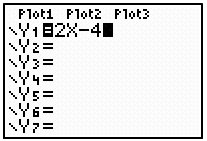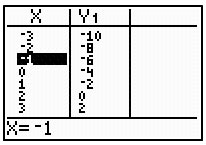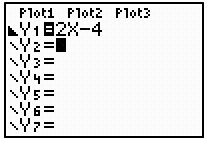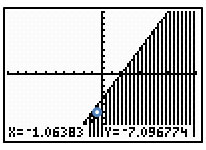If we substitute -1 for x and -7 for y, we will have the following:
4x − 2y > 8
4(-1) − 2(-7) > 8
-4 + 14 > 8
10 > 8
Since 10 is greater than 8, we know that (-1, -6) is a solution to the inequality.
Make a table of values.
Step 1:
Enter the inequality in the function editor (Y=).
Remember that first, you may need to write the inequality in Y = form, or solve the inequality for y.
4x − 2y > 8
4x – 4x − 2y > -4x + 8
-2y > -4x + 8
-2y over -2
-2y
-2
> -4x over -2
-4x
-2
+ 8 over -2
8
-2
y < 2x − 4

Step 2:
Look at the table of values. Scroll to locate the x-value of -1.

The table of values shows that when x = -1, y = -6. Our test point is (-1, -7). Compare the y-value from the table with the y-value from the test point.
y-value from test point < y-value from table -7 < -6
Since the y-value from the test point is less than the y-value from the table, the test point makes the inequality true. So, we know that (-1, -7) is a solution to the inequality.
Step 1:
Enter the inequality in the function editor (Y=).
Remember that first, you may need to write the inequality in Y = form, or solve the inequality for y.
4x − 2y > 8
4x – 4x − 2y > -4x + 8
-2y > -4x + 8
-2y over -2
-2y
-2
> -4x over -2
-4x
-2
+ 8 over -2
8
-2
y < 2x − 4

Because we want to see y-values that are less than the expression 2x – 4, set the graph to shade beneath the graph.
Step 2:
Look at the graph. Locate the test point, (-1, -7).
Because the test point lies within the shaded region, we know that (-1, -7) is a solution to the inequality.
